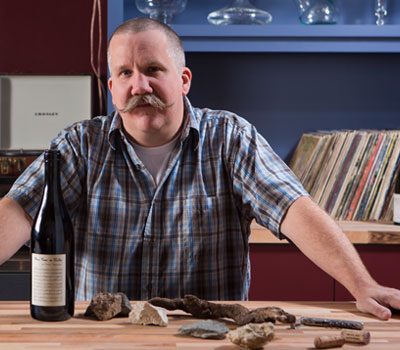After four years running the wine program at Husk, Memphis native Matt Tunstall left to open his own place in 2016. At Stems & Skins, a wine bar in the Park Circle neighborhood, he focuses on low-intervention wines with the sort of foods that encourage drinking—like Ibérico ham, duck rillettes, smoked sardines and artisan cheeses. Last January, the locals were still testing him out, ordering wines by the glass; now, he says, it feels like his place has finally made the cut, as diners are increasingly going all in, and drinking ever more widely around his list.


On trust
The biggest change [since opening] is that we’ve been able to curate a really great staff. About a year-and-a-half in, people started to knock on our door—people interested in cocktails, wines, all the geeky stuff, wanting to work here. That’s part of the reason we’re selling more bottles: Glass sales made up 85 percent of our wine sales for the first year, as people wanted to taste everything before letting us talk them into anything. That switched last summer; glass-to-bottle sales are more like 65/35, even 60/40 now.
On managing expectations for “natural” wines
A few times a month, I’ll have someone come in and say, ‘I want something odd as hell, super funky, bacteria-driven,’ and I keep a few bottles around for those people, but for the most part, I prefer wines that are cleaner and more resolved. My rule is, if you can’t drink the whole bottle, I don’t want it. There are some that are so funky that one glass is enough. It’s interesting that the range of wines have inspired a big conversation on what natural wine is. I’m seeing a lot of interest in orange wines, too—people are reading about them, and then coming in and asking for them.
On go-to regions for natural wines
Emilia-Romagna is a hotbed of hip pie winemaking, for sure; lots of fun bottles and inexpensive, every-day guzzlers coming out of there: Denny Bini, Camillo Donati, Denavolo…
We also sell lots of gamay, funky indigenous varieties from the Loire, hands-off wine from Languedoc. Zev Rovine wines just got here; we get Jenny & François as well as Dressner stuff [all importers focused on natural wines]. The Mas de Chimières does really well, especially in wintertime—we have a lot of fun with old-vine grenache and carignan. I don’t think guests are looking south because of the price point; they are just happy they get a $9 glass of wine that’s fantastic.
On what’s not happening
Alsace. It’s not that people won’t drink it; it’s that there’s not much stuff that’s available here yet. You get Trimbach and Zind-Humbrecht, the big guys, but I know there’s another generational push in that neighborhood, and we just don’t see it.
On a Rioja as your most successful new addition to the list.
That’s one wine we’ve killed in the last three or four months: It’s Olivier Rivière, a Frenchman married to a woman from Rioja, so you get French winemaking technique on Rioja grapes. It’s low on oak, not too ripe—a fun little wine that some of the staff have really gotten behind. In Spain, in general, I’ve seen lot of excitement in the northwest—the Evinate wines, bottles from Ribeira Sacra, Valdeorras—as well as wines from the Canary Islands: Spanish wines with acidity; they aren’t all glop.
is W&S’s editor at large and covers the wines of the Mediterranean and Central and Eastern Europe for the magazine.
















